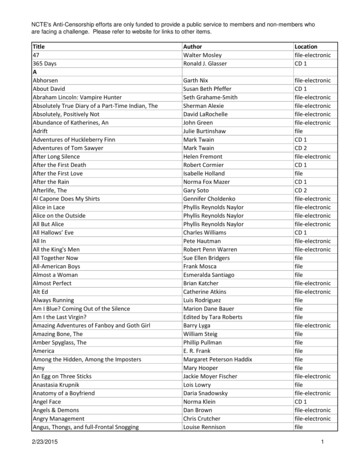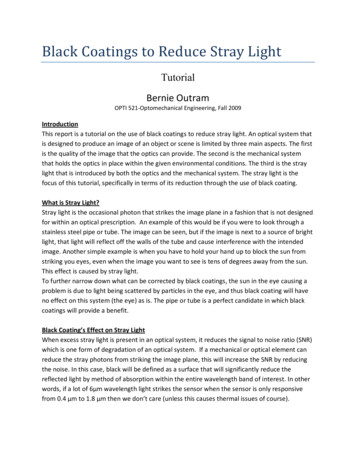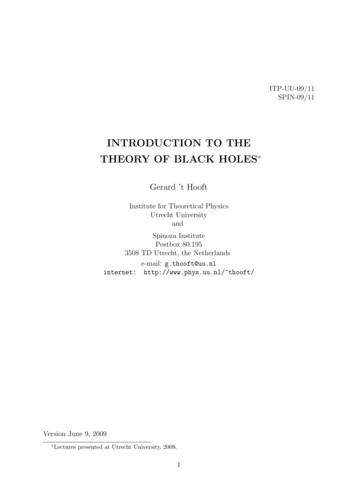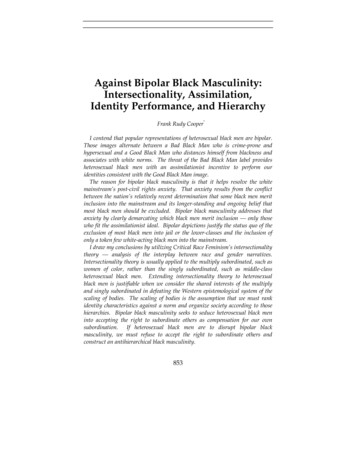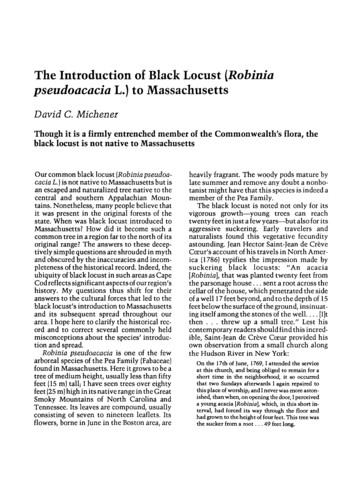
Transcription
The Introduction of Black Locust (Robiniapseudoacacia L.) to MassachusettsDavid C. MichenerThough it is a firmly entrenched member of the Commonwealth’s flora, theblack locust is not nativetoMassachusettsOur common black locust (Robinia pseudoacacia L.)is not native to Massachusetts but isan escaped and naturalized tree native to thecentral and southern Appalachian Mountains. Nonetheless, many people believe thatit was present in the original forests of thestate. When was black locust introduced toMassachusetts? How did it become such acommon tree in a region far to the north of itsoriginal range? The answers to these deceptively simple questions are shrouded in mythand obscured by the inaccuracies and incompleteness of the historical record. Indeed, theubiquity of black locust in such areas as CapeCod reflects significant aspects of our region’shistory. My questions thus shift for theiranswers to the cultural forces that led to theblack locust’s introduction to Massachusettsand its subsequent spread throughout ourarea. I hope here to clarify the historical record and to correct several commonly heldmisconceptions about the species’ introduction and spread.Robinia pseudoacacia is one of the fewarboreal species of the Pea Family (Fabaceae)found in Massachusetts. Here it grows to be atree of medium height, usually less than fiftyfeet (15 m) tall; I have seen trees over eightyfeet (25 m) high in its native range in the GreatSmoky Mountains of North Carolina andTennessee. Its leaves are compound, usuallyconsisting of seven to nineteen leaflets. Itsflowers, borne in June in the Boston area, areThe woody pods mature bylate summer and remove any doubt a nonbotanist might have that this species is indeed amember of the Pea Family.The black locust is noted not only for itsvigorous growth-young trees can reachtwenty feet in just a few years-but also for itsaggressive suckering. Early travelers andnaturalists found this vegetative fecundityastounding. Jean Hector Saint-Jean de CreveCoeur’s account of his travels in North America ( 1786) typifies the impression made bysuckering black locusts: "An acacia[Robinia], that was planted twenty feet fromthe parsonage house. sent a root across thecellar of the house, which penetrated the sideof a well Jfeet beyond, and to the depth of 155feet below the surface of the ground, insinuating itself among the stones of the well. [I]tthen . threw up a small tree." Lest hiscontemporary readers should find this incredible, Saint-Jean de Creve Coeur provided hisown observation from a small church alongthe Hudson River in New York:heavily fragrant.On the 17th ofJune, 1769,attended the servicethis church, and being obliged to remain for ashort time in the neighborhood, it so occurredthat two Sundays afterwards I again repaired tothis place of worship; and I never was more astonished, than when, on opening the door, I perceiveda young acacia [Robinia], which, in this short interval, had forced its way through the floor andhad grown to the height of four feet. This tree wasthe sucker from a root . 49 feet long.at
53Modern black locusts are no less vigorous;the asphalt sidewalk in front of my Arboretum residence is plagued by Robinia suckersfrom a tree situated a good thirty feet away.frequently recommended it [Robinia trenails]Resistance toall my endeavours, the use of locust tree-nailsstill continued to be little practiced orknown, till it happened to be adopted by abuilder of some eminence at New York, andof late years has been introduced into generaluse there, and in some parts of New England:but, as yet, the use of the locust-tree in shipbuilding is confined to the article of tree-nailson account of its scarcity." The major useDecayOf great importance to colonists to the southof Massachusettswasthe soon-discoveredresistance of Robinia pseudoacacia wood todecay. The naturalist Mark Catesby( 1767/, aswell as Saint-Jean de Creve Coeur (1786),comments on the high esteem in which thewood was held by Americans farmers for thisreason. Robinia wood was prized for fence-.but all to no purpose, till about 20 years ago[the 1760s] when I was settled in trade atRhode Island, I persuaded some ship-buildersto try the experiment: but, notwithstandingposts and construction timber in contactwith the ground. It was also noticed thatRobinia plants would colonize poor, dry soils,thus giving farmers marketable timber fromotherwise marginal land. [This is due in partto the nitrogen-fixing ability of symbioticbacteria in the root nodules of Robinia, asymbiosis common in the Pea family.] Thevalue of Robinia wood in the early 1800s wasdemonstrated by Michaux, who noted(quoted in Withers, 1842) that "[Robinia is]allowed to remain standing in the newlycleared lands, because the inhabitants cannever have enough of the wood."Agricultural use turned out to be only onefacet in the development of a market forRobinia wood. Withers’ friend Joseph Harrison, in a letter of 1782 (printed in Withers,1842), recalled from firsthand experience thetrials of Robinia in American shipbuilding"about 1733." Robinia wood was used fortrenails /pegs used to fasten planks to a ship’sframe), instead of iron, with great success."When unloaded she [the ship] was hauledashore upon the bank in order to be searchedboth outside and inside, when, on the strictest examination, it was found the locust treenails, that had been substituted instead ofiron bolts, seemed, to all appearance, to haveeffectually answered the purpose intended."This development did not, according toHarrison, spread quickly in shipbuilding. "IRobiniapseudoacaciain wmter. This tree (growinggCzechoslovakia) was sixty-three feet tall; itstrunk was nearly fifteen feet in circumference.Photograph (dating from 1905) from the Archivesinof the Arnold Arboretum.
54 1of Robinia trenails in shipbuilding producedsignificant market. By 1819, Philadelphiaalone annually exported over one hundredthousand Robinia trenails for ship construcation.Several clues have about the introductionand naturalization of Robinia pseudoacaciain New England have come to light: durablewood useful in shipbuilding and agriculture,rapid growth of young trees even on poorsoils, and clonal growth of groves from initialplantings. Include the the aesthetic attraction of fragrant blooms and one has themakings of a tree popular in a rural, maritimeeeconomy.The first myth (and an entrenched one atthat) concerns the initial source of Robiniapseudoacacia. Linnaeus, the great Swedishbotanist, named the genus Robinia in honorof Jean Robin ( 1550-1629/, a major botanist atthe Jardin des Plantes in Paris. Robin is usually credited with introducing seeds ofRobiniafrom Canada in 1600 or1601. A Canadian seed source at this timewould certainly imply that Robinia couldwell have been native in New England, too.However, Charles Sprague Sargent (1892)reiterated the claim that it was the son of JeanRobin, the botanist Vespasian Robin(1579-1662), who introduced the plant toParis in 1636, and this without a definitesource. In this case, which I take to be correct(remember that Linnaeus was writing over acentury after the latter date), the error inciting a Canadian source for the originalFrench introduction has little bearing on ourquest.Early American records can be divided intotwo groups: those that note a peculiar newtree that can be identified as Robinia andthose that make no note of a tree with anycombination of its distinguishing characteristics (floral fragrance, woody pods, durablelumber, rapid growth, and clonal habit). William Strachey (quoted in Sargent, 1892) sawduring his journey into Virginia in 1610 "akynd of low tree, which beares a cod like toto Francethe peas, but nothing so big," and he observedthat the Indians used it to make bows.Strachey’s observation has been taken to beone of the earliest records of black locust(Sargent, 1892), but it could also refer to theredbud, Cercis canadensis L. While Robiniawas found at the time of the establishment ofthe southern colonies, what of Massachusetts ? Here we come to the second myth.Apparent Source of the ErrorA statement in the seventh edition ofPhilipMiller’s authoritative Gardeners Dictionary(1756-1759) appears to be the original incorrect citation of the "fact" that Robinia woodwas used in the first buildings of Boston, a"fact" that quickly found its way into theEuropean botanical literature. (See, for example, the citation of Jose Quer, 1762, inAustrich, 1987.) The statement in theGardener’s Dictionary is:This Sort grows to a very large Size in America,where the Wood is much valued for its Duration;mo f t of the Hou f es which were built in Bo f ton inNew England, upon the firft Settling of theEnglifh, was with this Timber, which continuesvery found at this Time.As this in the only reference I have found to anoriginal presence of Robinia in Massachusetts at the time of settlement (other than thepossibility that it could have been here if thespecies had been introduced from Canadaaround 1601),the veracity of this "fact"(written over a century after the settlement ofBoston) must be evaluated critically. I havefound no evidence to support the statementbut have found numerous cases that castsevere doubt upon it.Massachusetts is fortunate that its earlysettlers were literate and left written records,including notes of new plants. John Josselyn’sNewEngland’s Rarities Discovered in Birds,Beasts, Fishes, Serpents, and Plants of thatCountry (1672) has sections on "Plants as areproper to the Country" and "Of such plants asare proper tothe country, and have no name.""
55Here, for many pages,are featured such novelties as pitcher-plants under the name of"Hollow Leaved Lavender," Indian beans,squashes, sumach, hemlock trees, pitch trees(here meaning Abies), larch trees, "cranberry," pyrola, a "hellibore" with the note"the whole plant scents as strong as a fox"(skunk cabbage to us), plus a weirdly fancifulsketch that seems to have more to do withEzekiel’s vision of wheels-in-wheels thananything truly terrestrial. Nothing like aRobinia is mentioned, figured, or described.Josselyn also authored his Voyages, or accounts of his sea voyages to and adventures inNew England. Published in 1675, it has onlyone possible reference to an unknown treethat might be a Robinia: "The Line-tree withlong nuts, the other kind I could never find."William Wood’s propagandistic NewEngland’s Prospect ( 1634) also lacks any reference to a tree with the characteristics of aRobinia.The botanical explorers and writers of thelate 1700s and early to mid-1800s leave littleroom to believe that Robinia pseudoacaciawas ever native to Massachusetts. The Rev.Manasseh Cutler’s Account (1785) describedthe species as native to "southern statesonly cultivated here." Fran ois Michaux(citedinthat theWithers, 1842) categorically statesdid not grow naturally in anytreestate east of the Delaware River, trees in thoseareashaving been planted. DanielBrowne(1832) reiterated Michaux’s statement andnoted that the wood was not much used inconstruction except to support the sillsfurther evidence that Miller’s source wasincorrect. Torrey’s Flora of the State of NewYork (1843)described the tree as "not indigenous in any part of the State . [A]lmostnaturalized in many places." Finally, GeorgeB. Emerson’s Report on the Trees and ShrubsGrowing Naturally in the Forests of Massa-/ 1846/ concisely claimed that"[Robinia] is not known to be, nor is it generally considered, a native of the State or of NewEngland; and it is doubtful whether it grewchusettsnaturally in the northern part of the MiddleStates. It does not grow spontaneouslynearthe sea-coast,evenin the SouthernStates.""Escape and NaturalizationNote the gap in time from the earliest colonial records of New England, in which blacklocust is not mentioned, to the botanicalwritings of the late 1700s and early to mid1800s, in which Robinia pseudoacacia is described as naturalized. A major developmentin the Robinia story occurred in this period.First was the destruction of the original forests in Massachusetts (and the other colonies)as the colonists changed the forested territoryto settled farm and pasturelands. New England is probably more forested at present (the1980s) than at any time since the arrival of thecolonists, thus it is easy for us to forget thatmuch of the arable land of thestate waspractically clearcut. In addition, grazing wasa component of agricultural settlement andmuch additional land, including parts of CapeCod and the islands, was further stressed bythis factor. Second, various attempts weremade to reforest some of the abused land andexotic species were certainly tried. Evidenceof more recent trials can be seen in the earlyecological literature, as where an old privatereforestation at Woods Hole was evaluated(Chrysler, 1905/. The condition of this property in 1850-essentially deforested-wasundoubtedly a widespread condition and wasanything but new.The reforestation of New England occurred primarily through the natural forces offorest succession on abandoned farms andpastures. Black locust probably became locally common by escaping from cultivationonce it had been planted. Saint-Jean de CreveCoeur’s account ( 1786) of the rapid spread ofRobinia pseudoacacia in the colonies focuseson all the critical points of human interest forgrowing the tree: the fragrance of its flowers,the durability of its wood, and the rapiditywith which it grew vegetatively, even on poor
5G .Specimen of Robinia pseudoacacia in the Royal Botanical Gardens, Kew, plantedAugusta of Wales. Photograph by and courtesy of Istvkn Rbcz.soils. Saint-Jean de Creve Coeur recounts thedevelopment of nurseries for the productionof robinias, and the establishment of robiniason Long Island, New York, on a major scale.He does not overlook New England:It has been already observed, that the Americansplant the acacia [Robinia], with the view of meliorating such poor and defective soils, as they intend to put under crop, for a series of years; and, asthe woods annually diminish in the inhabitedparts of the country, it is no uncommon thing tosee the old forests replaced by plantations ofacacias. It is in Long Island, New Jersey, Provi-in 1762byPrincessdence, and in the vicinity of Boston, that I haveparticularly noticed the good effects of these plantations. In several places there were formerlymoveable sands [that] by means of inclosures ofacacias, and by planting a great number of trees indifferent ways, these moveable sands have beenfixed.He also notes thetendency of Americans toblack locusts as shade trees near wateringspots, and to hold firm eroding river banks.Black locust must have been introduced toMassachusetts by the mid-1700s (Catesby,1767, recorded it as "very numerous in mostuse
57ofnorthern colonies"), the introductionhaving been driven by the overlapping forcesof strong demand for the wood in both agricultural and marine markets, by the then-ongoing destruction of the original forests, and bythe consequent need for a fast-growing treecapable of tolerating marginal agriculturalland. Robinia pseudoacacia fit all theseneeds. Since the species is semi-weedy, onceit was established within a region it was onlya matter of time before naturalized populations became permanent and the speciesspread as a part of the secondary woodlandson disturbed and abandoned sites.The Robinia craze in the United Stateswitnessed by Saint-Jean de Creve Coeur wasultimately thwarted by the presence of anative insect borer. The borers stunt individual trees, and greatly reduce the commercialquality of the wood. Sargent (1892) considered only the borers to prevent Robiniapseudoacacia from being one of the most important timber trees in North America. Asignificant Robinia craze swept Europe in theearly 1800s, aided in good part to the horticultural phenomenon in the person of one Mr.William Cobbett. Between 1817 and 1819 hemanaged a farm on Long Island, New York.He became enthralled with "especially theourFlowering Locust, or Acacia, which, in myopinion, surpasses all other trees, and some ofwhich, in this Island, are of very great heightand beauty" (Cobbett, 1828). Upon his returntoEurope, he establishedanursery and issupposed to have sold more than one millionRobinia seeds and trees; that leads to anotherchapter in horticultural history.There is an irony here. One Robinia crazefed another, and both ended with Robiniapseudoacacia permanently naturalized farbeyond its homeland in the central and southern Appalachian Mountains. Robinia’s naturalization has been so convincing that I havebeen assured-incorrectly-that the extensive groves of Robinia on Cape Cod mostcertainly are not artifacts of European settlement.ReferencesRicardo R. 1987. El Real Jardin Bot nico deMadrid and the glorious history of botany inSpain. Arnoldia, Volume 4 7, Number 3, pagesAustrich,(Quer is quoted on page 7.)1832. The Sylva Americana. Boston:W. Hyde and Company. 296 pages.Catesby, Mark. 1767. Hortus Europx Americanus. London : J. Millan. 41 pages.Chrysler, Mintin A. 1905. Reforestation at Woods Hole,Massachusetts.-A study in succession. Rhodora, Volume 7, Number 75, pages 121 to 129.Cobbett, William. 1828. A Year’s Residence in the2to24.Browne, Daniel J.Cutler,United States of America. Third edition.London: B. Bensley. 370 pages.Rev. Manasseh. 1785. An account of some of thevegetable productions, naturally growinginthis part of America, botanically arranged.Memoirs of the American Academy of Artsand Sciences, Volume 1, pages 396 to 493.Emerson, George B. 1846. A Report on the Trees andShrubs Growing Naturally in the Forests ofMassachusetts. Boston: Dutton & Wentworth. 547 pages.Josselyn, John. 1672. New-England’s Ramties Discovered. London: G. Widdowes. 169 pages. (Reprinted in 1865 by W. Veazie, Boston.)(Miller, Philip. 1756-1759. The Gardeners Dictzonary.Seventh edition. London: The author. Unpaginated.Saint-Jean de Creve Coeur, Jean Hector. 1786. Memoiresur la culture & les usages du faux Acacia dansles ,tats-Unis de 1’Amerique septentrionale.Memoires d Agziculture (Pans], pages 122 to143. (Bound separate in the Arnold Arboretum/Gray Herbarium library. Also translatedin Withers, 1842 [below].)Sargent, Charles Sprague. 1892. The Silva of NorthAmerica. Volume 3, Anacardiacex-Leguminosx. Boston and New York: Houghton,Mifflin and Company. 141 pages (Robinia,pages 37 to 42).Withers, William. 1842. The Acacia Tree. London: Longman. 411 pages.A compendium of all articles about Robimapseudoacacia that were known to Wtthers.Included are extracts from many articlestranslated mto EnglishWood, William. 1634. New Englands Prospect. London:Thomas Cotes. 131 pages. (Reprinted in 1865by John Wilson & Son, Boston.)David C. Michener directs the Arnold Arboretum’sLiving Collections Verification Project.
The Introduction of Black Locust (Robinia pseudoacacia L.) to Massachusetts David C. Michener Though it is a firmly entrenched member of the Commonwealth’s flora, the black locust is not native to Massachusetts Our common black locust (Robinia pseudoa- cacia L.) is not native to Massachusetts but is an escaped and naturalized t
